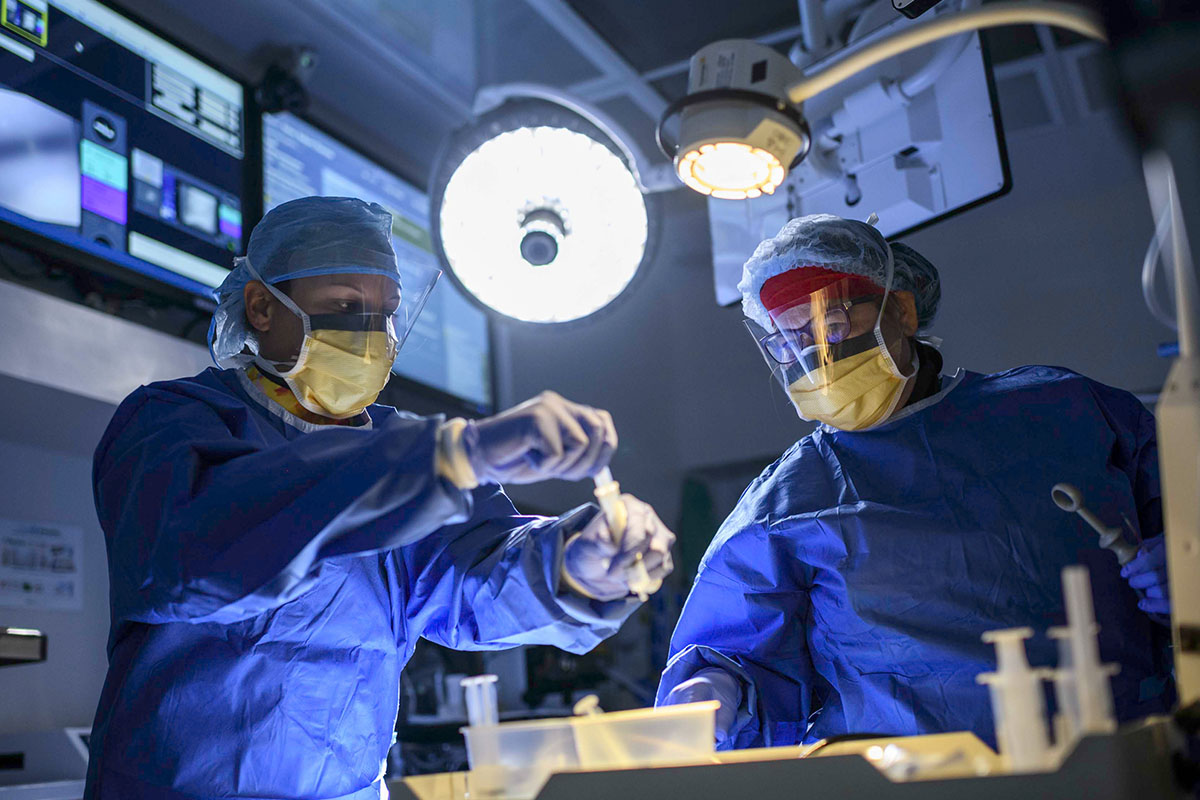Updates 9/2/25: Dr. Bott, pathologist Marina Baine, MD, PhD, and interventional pulmonologist Or Kalchiem-Dekel, MD, recently led the first study to evaluate the yield and accuracy of ssRAB-obtained biopsy specimens across all stages of lung cancer. The retrospective review evaluated results for MSK patients who underwent shape-sensing robotic-assisted bronchoscopy (ssRAB) between October 2019 and December 2023. The study found that ssRAB is a viable tool for adenocarcinoma subtyping with diagnostic yield and performance comparable to image-guided transthoracic needle biopsy, yet with superior safety. SsRAB accurately identified lung adenocarcinoma patterns in 71% of all cases and 79% of samples obtained by surgical resection, with an accuracy of 68% for samples with poorly differentiated histology. The paper was published in July 2025 in Lung Cancer.
Additional study updates: Dr. Bott and colleagues shared details of their learning curve acquiring skills with ssRAB at MSK in a paper published in January 2025 in the Journal of Thoracic Cardiovascular Surgery. They also published a retrospective study that demonstrated ssRAB provides high-quality samples that can be used for genetic testing. The study was published in the Journal of Thoracic Cardiovascular Surgery in November 2022.
Finally, MSK has expanded the number of ssRAB-certified physicians on staff to 11 and continues to offer ssRAB for diagnosing suspicious lung nodules as part of standard care for a growing number of patients, now more than 500 patients annually.
Shape-sensing robotic-assisted bronchoscopy (ssRAB) may improve the diagnostic yield of suspicious pulmonary lesions while providing an excellent safety profile, according to a study by Memorial Sloan Kettering Cancer Center (MSK) investigators published recently in Chest. (1)
The study was the first to report substantial clinical evidence on the performance of this recently introduced technology within a multidisciplinary, high-volume institution. It also represented the first collaboration between thoracic surgeons and interventional pulmonologists in the field of diagnostic bronchoscopy.

“Shape-sensing robotic-assisted bronchoscopy allows for more precise navigation further out into narrow airways of the lung, resulting in higher diagnostic yield from suspicious lung nodules compared with traditional guided bronchoscopy,” says interventional pulmonologist and study author Bryan Husta, MD, FCCP.
“Our evidence shows that the ssRAB platform improves our ability to sample challenging lesions significantly while delivering similar or lower complication rates than traditional guided bronchoscopy,” says thoracic surgeon Matthew Bott, MD, co-senior study author. “Greater efficiencies are translating to faster diagnoses and shorter times to treatment for patients with malignant lesions.”
Shape-Sensing Robotic-Assisted Bronchoscopy: How It Works

Traditional guided bronchoscopy uses a catheter with a stiff curvature and relies on electromagnetic navigation to locate and sample lesions. By contrast, ssRAB technology uses an articulating robotic catheter that allows for navigation into further reaches of the lung periphery while retaining stability and shape for maximizing sampling precision. (2)
A pre-procedural CT scan identifies the target nodule location and creates a roadmap of the best path for access with the ssRAB’s robotic catheter. During navigation, the ssRAB provides real-time 3-D imaging and information on the angle of approach and distance to target as the robotic catheter travels to the lesion. The ssRAB platform allows for consecutive sampling of multiple lesions and performing endobronchial ultrasound (EBUS) for mediastinal staging of lung cancer in the same procedure, saving time compared with performing separate diagnostic procedures.
MSK thoracic specialists have been pioneering the use of the Ion Robotic-Assisted Endoluminal Platform (Intuitive Surgical, Inc., Sunnyvale, California) since the US Food and Drug Administration (FDA) cleared the device in the fall of 2019. (3)
Key Study Findings and Implications
Patients with pulmonary lesions were referred to MSK’s interventional pulmonology or thoracic surgery services. MSK physicians performed diagnostic sampling and captured prospective data for 159 pulmonary lesions targeted during 131 consecutive ssRAB procedures between October 2019 and July 2020. (1)
The median lesion size was 1.8 cm, with 59.1 percent located in the upper lobe and 66.7 percent found beyond a sixth-generation airway. (1)
The navigational success rate of the ssRAB was 98.7 percent. (1) Diagnostic yield was 81.7 percent, much higher than historical rates of 44 percent to 74 percent with guided bronchoscopy. (4) (5) (6) (7) (8) (9) (10) (11) (12)
Remarkably, the diagnostic yield for typically problematic lesions 2 cm or less was 69.9 percent, (1) higher than the previously reported range of 43 percent to 59 percent for guided bronchoscopy. (8) (9) (12)
Lesions 1.8 cm or larger were significantly more likely to be diagnostic compared with those smaller than 1.8 cm, with an odds ratio of 12.22, according to multivariate analysis. The sensitivity and negative predictive value of ssRAB for identifying primary thoracic malignancies were 79.8 percent and 72.4 percent, respectively. (1)
The overall complication rate was 3.0 percent with a pneumothorax rate of 1.5 percent, in line with (8) (9) (13) (14) or improved, compared with previously published guided bronchoscopy studies. (6) (15) (16)
MSK has nine ssRAB-certified physicians on staff. Collectively, they perform a high volume of procedures, more than 200 annually.
Shape-sensing robotic-assisted bronchoscopy has become an essential component of standard practice at MSK for diagnosing lung nodules. MSK thoracic specialists look forward to results of the manufacturer-sponsored PRECiSE trial (NCT03893539) in progress, a prospective, clinical study that is assessing the clinical utility and performance of the device in 360 patients.
“Our study reported on our experience with the first iteration of this technology,” Dr. Bott says. “We expect this field will continue to evolve and improve over time and will continue pioneering advancements that improve our diagnostic capabilities.”
Learn More About MSK’s Multidisciplinary Thoracic Service
At MSK, thoracic surgeons and pulmonologists share different areas of expertise and collaborate on diagnosis and treatment procedures to improve patient outcomes. As a result, our patients receive collaborative, seamless care from an integrated team of specialists.
Dr. Husta and Dr. Bott receive speaker fees from Intuitive Surgical, Inc. Please refer to the paper for disclosures from other MSK study authors.
